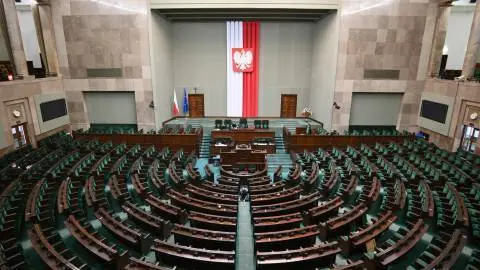Poland’s new majority to transform election platform into a viable economic strategy
The process of forming Poland's new government after elections took place on 15 October could take until Christmas. We see five broad strategic priorities for the new government, which could raise the growth potential of the Polish economy and help fund record-high borrowing needs and some pre-election pledges
Wind of change in Poland’s politics
General elections in Poland that took place on 15 October brought a shift in the political ground, with the new government expected to be formed by the coalition of the opposition parties led by Civic Coalition (KO). The Law and Justice party (PiS) which ruled over the last eight years will likely lose power. In such a scenario, a new majority is to replace a government that has been on a collision course with the European Union over recent years. The conflict between Warsaw and Brussels over the rule of law should hopefully be resolved, unlocking transfers from both the Recovery and Resilience Fund (RRF) and cohesion policy funds from the new 2021-27 EU budget. We discuss the EU funds prospects in a separate article here.
Force awakens
In the general elections in mid-October, voters chose new members of the 460-seat lower house (Sejm) and 100-seat upper house (Senate). The turnout hit a record high of 74% – about 10 percentage points more than during the first partially free elections on 4 June 1989 which paved the way for the collapse of communism in Central and Eastern Europe. The record-high turnout gives a strong mandate to a new government.
Even though PiS gained the highest number of votes, it'll most likely be unable to form a government. Even with its potential coalition partner, the right-wing Confederation party, it lacks the majority needed to gain a confidence vote. United opposition i.e., Civic Coalition (Koalicja Obywatelska – KO), Third Way (Trzecia Droga – TD) and the Left have 248 seats and declare to take joint responsibility in forming a new cabinet. The upper house – the Senate – is likely to be dominated by these allies, with the KO, TD and the Left securing 66 out of 100 seats.
Number of MPs in Poland’s 460-member Sejm after the 15 October general elections

Expected steps in forming the new cabinet
Even if opposition parties managed to secure a sufficient majority to form a new government, the process may still take some time. The first gathering of the new parliament is scheduled for 13 November – just a day before the constitutional deadline. Within 14 days of the first session, the President has 14 days to appoint a prime minister candidate. Then, the candidate has another 14 days to secure a vote of confidence from the new Sejm.
It is customary in Poland that the President gives the mission to form a new government to the leader of the party that won the elections, but he is not bound by any regulations at this stage. Before the elections President Duda clearly stated that he will stick to the tradition so in the first constitutional step on the new government forming he may appoint a PiS representative as a prime minister candidate (potentially current PM Morawiecki). Since such a cabinet is unlikely to pass the vote of confidence, the second step envisaged by the Polish constitution is likely to be needed to produce a new government.
In the second step, the initiative is on the Sejm side as any 46 members of parliament may propose its PM candidate. We believe that in this step the new cabinet capable of securing a vote of confidence will emerge. In such a scenario, Poland should have a brand new government by mid-December or slightly earlier.
Deadlines in the process of forming the new government in Poland

A new hope to be delivered, otherwise PiS may strike back
When in place, the newly formed government will have several urgent matters to address. First, it needs to prepare a new budget in order to avoid giving President Duda a chance to shorten the term of the parliament. According to the constitution, the president has such a right if a new budget is not approved within four months from the moment the government sends it to the parliament. What is more, opposition parties will like need to pencil in some of its fiscal pledges already in the 2024 budget act, potentially boosting already high deficit and borrowing needs even more (we discuss this issue in a separate fiscal article).
Another burning issue is unlocking the RRF funds. The European Commission will expect formal actions towards restoring the rule of law by the new authorities. However, given that the President and the Constitutional Court may not necessarily want to cooperate on legal changes, advancing on this in order to unlock the EU money, will need to rely on de facto changes within the existing framework rather than radical legislative changes. We discuss EU funds in a separate EU funds article. After last week’s visit of candidate to PM Tusk, it seems that the EC may unlock EU funds even without final acceptance from President Duda and the Constitutional Court. Passing the new law by Parliament should be enough to satisfy the horizontal milestone on rule of law to unlock RFF funds.
In general, the outgoing PiS is to be a tough opposition and will not facilitate the job of the new government with a radical reform agenda. As for any other political party, its main goal will be to return to power as quickly as possible.
Five broad priorities for the new government
We see five broad priorities for the future government:
First, there is a need for a paradigm shift in economic policy from support focused mainly on consumption to a greater support for investment. This refers to domestic investments through predictable tax policy. In the last eight years the unpredictable and rigourous tax policy has discouraged private outlays. As a result, Poland’s investment-to-GDP ratio decreased to 17%, much lower than in other Central European economies where this ratio varies between 25-28%. We also think there is a lot of pending FDIs driven by geopolitical concerns and nearshoring/friendshoring. The independent survey run by Reuters/Maersk find Poland as the number one nearshoring destination in Europe. This is an economic and political trend resulting from supply chain disruptions during the Covid-19 pandemic. Also, German businesses are preparing for the risk of worse relations with Asia / China. It is about shifting sourcing or investment activities of European or global companies closer to home markets or friendly countries. In our report on supply chains, we discussed how Poland could attract new investments in this context.
At the same time, unlocking EU funds from RRF and new cohesion policy would support public investments. They help lift Poland’s growth potential and support continued convergence of real incomes.
We see unlocking private investments, FDI’s and EU funds as low hanging fruits which can restore higher GDP growth, a key metric in debt sustainability analysis. Also, unlocked investments should help restore a less inflationary GDP structure, which in the last several years has relied mainly on consumption. The higher investment should mitigate price pressures and support further disinflation towards the 2.5% inflation target over the medium term. According to the CSO survey from summer 2023, the top-3 investment barriers for manufacturing companies (3,500 firms in the sample), were: high investment costs (55.6% of responses), high inflation (46.4%), and uncertain macroeconomic situation (37.2%).
Investment rate in CEE countries, as % of GDP

Second, labour market, pension and emigration policy needs to address the declining availability of labour from Poland and the rising cost of labour. Poland’s labour force shrank by more than 2 million during the last 15 years, and it is expected to shrink further by almost another million during the next 10 years. This gap has been filled to some extent by migrants, especially from Ukraine. In our view, the responsible migration policy may encourage foreigners to stay longer in Poland or attract other foreigners.
Poland’s working age population (19-59/64 years), million people

The next priority is depoliticising the energy transition, as Poland is the most exposed in the CEE region to expensive energy, through a highly carbon-intensive mix. As Europe’s natural gas prices largely normalised in 2023, Poland’s wholesale electricity prices with coal-fired units closing the merit order, belong to the highest in Europe. High carbon-intensity is not only an additional cost for Polish companies, but also an increasingly important factor for ESG-sensitive foreign investors.
While considering different investment locations, global companies are searching for partners or sub-contractors, offering clean energy sources. This is driven by the global megatrend to reduce emissions in the entire supply chain or life cycle of the product. Some companies already face this pressure from their business partners – see our report on firms’ reaction to the energy shock. During one of our business meetings in Southern Poland last week, a car parts producer mentioned last year’s requirement of having an ESG rating from a leading European car producer.
Poland needs to promptly accelerate energy investments to escape high and volatile fossil fuels and carbon prices. Otherwise, the country will face competitiveness losses. The expansion of solar energy in the recent three years in Poland is impressive (more than 5GW new capacity installed in PVs in both 2021 and 2022). But – because of the low load factor of these units – it does not change much the electricity production mix. The current situation reflects a decade of under-investments in the 2010s, both in clean energy supply and electricity grids. The latter has already become a bottleneck for further absorption of intermittent renewable energy sources into the electricity system.
Power production mix in CEE countries and Germany, 2021, in %

Priority number 4 is a new social contract to stagger (additional) high spending promises on top of those already contained in the 2024 draft budget with record-high net borrowing needs. We discuss this issue in a separate fiscal article, here we focus more on the demand side for the new Polish T-bonds. Financial markets are already pricing elevated high yields for longer in core markets. In such an environment, financing excessive fiscal needs is to be expensive. In its latest report, the IMF warned about Poland's general government deficit not falling below 4% of GDP by 2028. Fiscal policy needs to find a right balance between fiscal prudence and assuring sizeable investments in defence, energy or spatial inclusion. We realise this is easier said than done.
The rally in Polish assets just after the general elections reflects a vote of confidence from investors. But this confidence cannot be taken for granted. We saw it a year ago in the very mature British market, and investors reaction to the unstainable fiscal plan of PM Liz Truss. In 2024 the net borrowing needs should reach a record-high level of PLN225bn (6% of GDP) with the general government deficit about 4.8% of GDP. We see a space for 1% of GDP extra spending in 2024, lifting borrowing needs to 7% of GDP and general government deficit to 5.5-6% of GDP.
Bond yields (10Y) in UK, Germany, and Poland in 2022-23, in %

The final priority is about improving governance and institutions, from assuring an adequate system of 'checks and balances', transparency in public finances, predictable tax law, to improved governance of state-owned companies. The restored rule of law is expected by society, but also should unlock EU funds. The transparency in public finance is key for better controlling public spending, which outpaced public revenues, especially since the Covid-19 pandemic. Rating agencies reflect better institutions and transparency of public finances in a country’s assessments. Better institutions are also about predictable tax law, which is crucial for unlocking private investment, where Poland strongly underperformed CEE peers in the last years.
Given the above, we see upside risk for our short-term GDP growth forecast of 2.5% in 2024 and the years beyond.
This publication has been prepared by ING solely for information purposes irrespective of a particular user's means, financial situation or investment objectives. The information does not constitute investment recommendation, and nor is it investment, legal or tax advice or an offer or solicitation to purchase or sell any financial instrument. Read more
Download
Download article
30 October 2023
How Poland is back on a pro-European course This bundle contains 3 Articles




